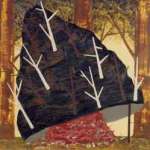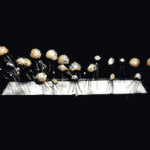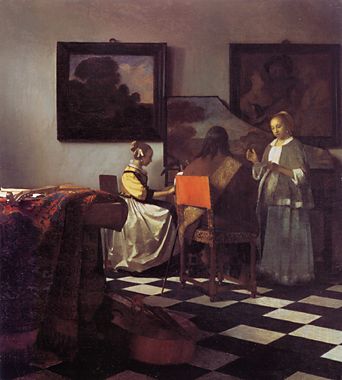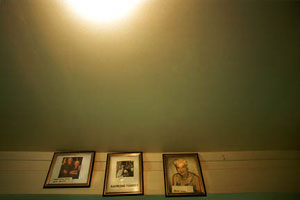“Discover cutting-edge work in SMFA alumni show” the museum states in its promotional material – as if the school across the street is nurturing some sort of present day avant-garde phenomenon. In all actuality this year’s exhibition is more of a discovery of the failings of arts education than anything “cutting-edge.” Exhibiting little skill and even less conviction, these eleven artists make a convincing case for a return to traditional learning and practice in contemporary art production.
The traditional apprenticeship model is, however, the reason that we find ourselves here celebrating these achievements. As its flagship program the school’s Diploma program was based initially on the idea that aspiring artists could not only choose their course of study but also their mentor – with this comes many unique features and benefits. The most intriguing of which is the eligibility of this small facet of the school’s alumni to advance their career by pursuing the “Fifth Year Certificate.”
Again, the school’s promotional material is enlightening: “Our Fifth-Year Certificate program is without parallel in the United States…With hard work, the year culminates in an exhibition at the School where a jury of art-world professionals selects work and awards the Fifth Year Exhibition and Competition scholarships. The sum of $90,000 in endowed funds is disbursed in travel grants to award recipients (individuals typically receive $5,000 to $20,000). If you receive a grant, you participate in the annual Traveling Scholars Exhibition at the Museum of Fine Arts, Boston. The exhibition is held in the main Contemporary Arts Gallery at the Museum where thousands of people will view your work.”
It would seem that the competitive nature of such a grant program would result in a higher standard – after all, recent reports assure us that only a small percentage of the over-saturated marketplace of art school graduates are allowed entry into the doorways of the world’s best galleries and museums. So it’s rather surprising that of the eleven scholarship recipients eight artists were chosen from the sixteen participants in the school’s “rigorous” Fifth-Year program. For those in the program, that’s a one in two odd of being featured in the Traveling Scholars exhibition. Quite a benefit for an emerging artist – one that would seem to surpass those of the school’s other programs: the Bachelor of Fine Arts and the terminal degree for professional artists, the Master of Fine Arts (from both of which three artists were chosen from more than two hundred alumni submissions). In two separate (but not equal) juries, this disproportionate exhibition was formed. One can only imagine the true happenings behind such a faltered grant and exhibition structure.
As a sort of dichotomy, the show displays both a clinging to and a fear of tradition that is often hallmark in the work of students. The art is hung in one of the nation’s most respected museums, so it immediately invites a sense of importance. The gratuitous wall text assures the viewer of its relevance and the guards ask you to not step in too closely -- but with closer inspection most of the featured works of art simply lack staying power. Perhaps it is the eagerness within many of the works to quietly exist on these walls that results in such blandness. There are few chances taken, little rigor displayed and virtually no fervor in communicating to the viewer.
This is not to say that the exhibition is completely devoid of value. The work of three of the featured artists is embedded with a sincere, and almost sentimental, optimism in their respective practices that is quite refreshing and deserving of consideration.
The untitled portraits by Benjamin Draper exhibit a fine handling and control of oil paint. The paintings’ subjects (the artist’s close friends) provide a link to the here and now that could easily be overshadowed by Draper’s nostalgia for historical painting. But these subjects’ pose and the manner of their representation (frontal, expressionless, ordinary) foregoes much conceptual contemplation and directs the viewer to primarily admire the works based on their skill. The wall text and the artist’s statement serve as buttresses to this aim by stating that the artist “is particularly engaged with the formal concerns of such artists as “Jean-Auguste Ingres, Edouard Manet and Edgar Degas” – a statement that the artist would be well-served to resist in the company of those fine artists. Comparisons in such close proximity are inevitable and once discovered it becomes evident that although Draper is well on his way to being a fine painter, he is no Manet.
Just as Draper clearly articulates himself as a portrait painter (something that until recently would have been considered rebellious in contemporary art), Riyo Hirota must be pleasantly relieved to discover that there are “art-world professionals” who support her commitment to metalworking. Learning the medium from her father in Japan, the artist primarily uses Sterling silver (alongside wax and wood) to highlight properties of nature and their similarities to industry. In a culture that offers every imaginable material and manner of thought to artists, Hirota’s return to that which she knows best – something that is part of her family history – would seem to be a very revitalizing gesture to the often cold and calculated strategies typical of younger art today. In spite of a manner of working that would seem rooted in antiquity, the mushroom-like forms of Biomorph evoke euphoric thoughts not too distant from the psychedelic Sixties. Hirota’s forms and craftsmanship come together to offer subtle, simple pleasures deeply rooted in material.
Claiming Seventies album art as its lineage, Jaya Howey is also content to explore idiosyncratic natural themes in his charming and naïve landscapes. Including such humorous and childlike images as a tree limb propping a hollow mountain over a small village of houses – the artist credits this point of departure with his “limited firsthand experience within the wilderness.” Handling paint more like a collage artist, Howey achieves captivating textures that become symbolic of those found in nature. For example, a scrape of translucent brown paint across a white impasto comes to represent tree bark. Short, impressionistic dabs form a pile of leaves (or wood, or compost, or bricks) – one is unsure. These generic signifiers of nature coalesce to offer the viewer a moment of escape into a storybook world via what would seem to be the complete opposite of en plein air -- painting landscapes from inside his Brooklyn apartment.
In the words of the museum’s director, Malcom Rogers “One of the things that gives art its mystery is the sorting out that time does. The bulk of contemporary art, whether it’s music or painting, time will erase.”* One gets the impression that the sorting has begun: Maria Casconcelos’ bankrupt allowance of “her acrylic paint to leave the canvas…questioning the traditional definition of painting” (does this really need to be questioned any further); Mary Oestereicher Hamill’s false and misguided attempts at social reformation by “collaboration with homeless men and women” (is this a responsibility that art must bear); and David Palmer’s masturbatory quotes of David Reed’s trademarked brushstroke (action-painting taken to a ridiculous and absurd degree via liberal appropriation). Alongside such superficial examinations of the worth and language of art – it can easily be seen why sincerity reigns among this group of Traveling Scholars.
- Jaya Howey, Untitled, 2003. Oil on canvas. Courtesy of the artist.
- Riyo Hirota, Biomorph,2003. Sterling silver, steel box and light bulb. Courtesy of the artist.
- Benjamin Draper, Untitled, 2003. Oil on canvas. Courtesy of the artist.
Links:
Traveling Scholars, 2003 is on display between February 8th - March 14th, 2004 at the Museum of Fine Arts, Boston.
*Excerpted from “Malcom Rogers” by Jonathan Soroff in The Improper Bostonian, March 3-16, 2004, p. 16.
All quotes are taken from the published brochure and wall text, which accompany the exhibition.
All images are courtesy of the artists and the Museum of Fine Arts, Boston.
Wesley Pierce received her M.A. from University of Missouri and her B.A. from Wellesley College. She is currently on sabbatical writing her upcoming book entitled “Sincerity and Religion in Contemporary Art.”







